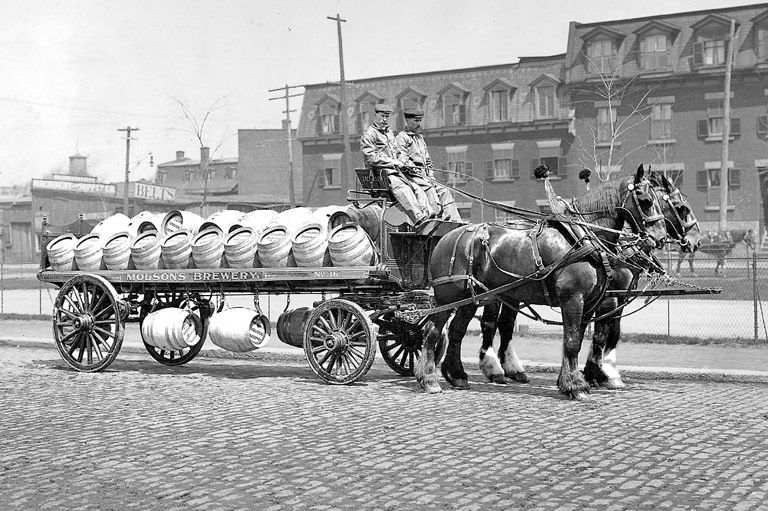Discover a wealth of interesting, entertaining and informative stories in each issue, delivered to you six times per year.
The Golden Age of the General Store
In July 1608, when Samuel de Champlain built his magazin, the first part of the Quebec habitation, he was founding not only a city and a country but also a Canadian tradition that has endured for almost four hundred years.
While there were earlier stores, on St. Croix Island and at Port-Royal in the Maritimes, Champlain’s little trading post was the first built in a settlement with a continuous human presence ever since.
Thus, when we celebrate the four-hundredth anniversary of Quebec City in 2008, we should also be celebrating an unbroken four hundred years of shopping.
For most of those four hundred years, we have shopped in small retailing establishments: trading posts, northern stores and company stores, merchant or outport stores; and in the thousands of agricultural settlements across the country during the last two centuries and more, we have shopped in general stores.
The pattern of Quebec was repeated thousands of times across the country: in most settlements, it was the store that helped found the settlement. Vancouver was founded by a store, the Hastings Mill store, now a museum. In Kindersley, Saskatchewan, once the Canadian Northern Railway chose the site for its station, the first store was in a tent, erected in a few hours.
The various terms store, magazine, and magasin (Champlain spelled it with a ‘z’) have long roots, dating back a thousand years when Arabs were the preeminent explorers and traders, and the Mediterranean, the centre of world trade.
The term general store came into use during the early part of the nineteenth century. In the 1830s, Catherine Parr Traill and Anna Jameson each noted the growth of what they referred to as “general” shops or stores in agricultural settlements of Upper Canada. Many of the first stores began in a room of a merchant's house, and often that merchant was a woman, who carried on household duties while serving her small community.
What most people remember about general stores was the array of goods, from horse harness to cheddar cheese, from flannel work shirts to chewing tobacco–in short, almost anything not produced on the farm. The store teemed with goods, displayed not only on floors and walls but also hanging by hooks from ceilings.
The merchant was paid by a combination of cash, often in short supply, and farm produce, from potash to eggs, chickens, grain, and firewood. Some bills were paid by labour: a blacksmith might shoe the merchant’s delivery horses to pay off a bill. Of course there were always customers who found ways to avoid paying. One customer in central Ontario used the line, “Wouldn’t you know it! I left my wallet in my other trousers.”
The credit system was a delicate balancing act, for the merchant had to be careful not to offend a recalcitrant customer while at the same time making certain that the store collected enough money to pay accounts at wholesale houses in nearby cities. One storekeeper ingeniously stole piglets from a farmer who owed a large bill. But that’s another story.
Storekeepers themselves played important roles in their communities. They were often fire chiefs and telephone centrals. When asked, they gave advice on marriage and mental depression. In some cases, the storekeeper was appointed justice of the peace. In the evenings, they became club managers who hosted games of checkers and gatherings around the store radio to hear sporting events. Storekeepers witnessed peccadilloes and hypocrisy, and thus they made witty storytellers. One Moncton-area store-keeper was such a good storyteller that he was hired by the CN as an after-dinner speaker.
Not only did they keep people in food and clothing, sometimes as an act of charity, they were also small bankers, lending money when banks were more conservative. Banks often used general storekeepers as their rural agents. The first branch of the now powerful Caisses de depot Desjardins was inside a little general store in Levis, opposite Quebec City.
Because stores kept pools of cash on hand, to redeem pay or grain cheques, they were often the envy of robbers. John Diefenbaker rarely lost a case, but in 1933, he was unsuccessful in defending a young man who had murdered a storekeeper while stealing a few hundred dollars. The man was hanged the following year.
The golden age of general stores, roughly the nineteenth century and early twentieth century, gradually ended with the motor car, catalogue shopping, and community splintering as well as with the rise of urban department and specialty stores.
Today a few general stores operate, mostly in villages and towns far removed from cities. When Canadians “shop” in general stores now, they do so mostly in museums. General stores have also moved into the realm of the imagination.
There are stores in novels such as Annie Proulx’s The Shipping News and W. O. Mitchell’s Who Has Seen The Wind?, in films such as Margaret’s Museum and Mon Oncle Antoine; and in the teleroman, Les belles histoires des pays d’en haut.
As Canadians prepare to celebrate four hundred years of shopping, we could do no better than to reconstruct Champlain’s habitation with its little magazin, built that midsummer of 1608 when Canada began with a store.
Themes associated with this article
Advertisement
You might also like...

Canada’s History Archive, featuring The Beaver, is now available for your browsing and searching pleasure!











